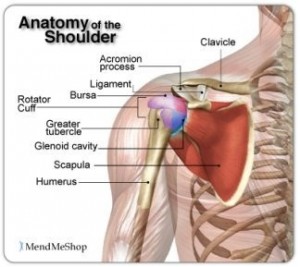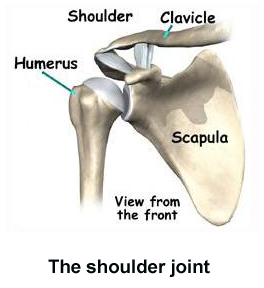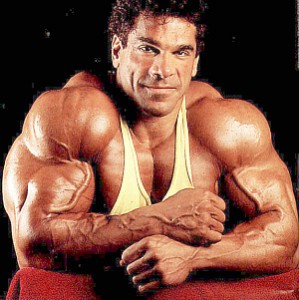The Knee Joint – Injury Prevention
By: Todd Riedel
Speaking as a forever-active individual and 17-year football veteran, I can tell you you’re as old as your knees. For me, it wasn’t the usual suspects of running, football, basketball or weightlifting that added unwanted years to my knees. Aches, pains, and four knee surgeries later, I finally learned these injuries were a result of improper coaching as a youngster.
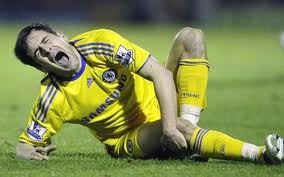 As an athlete you need to be careful not to overuse or abuse your knees by putting unneeded torque and stress on the joint. Poor squatting form, increased shin angles and lifting too much weight too fast can be stressful on the tissue within or around the hinged joint.
As an athlete you need to be careful not to overuse or abuse your knees by putting unneeded torque and stress on the joint. Poor squatting form, increased shin angles and lifting too much weight too fast can be stressful on the tissue within or around the hinged joint.
Any exercise with rigorous knee bending, cutting, or change in direction can quickly lead to problems. Your body also needs time to recover, so if you or your knees feel overworked then they probably are. If that is the case then simply back off. I’m not saying you need to be “SOFT” or weak minded, and I’m not saying you need to reduce effort in your training. I am saying listen to your body and if you are experiencing swelling in that joint then reduce the training volume a bit.
In my opinion weight training is great, but only if it is prescribed by a true professional. One thing most people fail to understand is that the body must be trained with balance. Imbalances can stress the body in many different ways; for example, too many chest presses could lead to bad posture, too many squats can lead to knee problems, and too many serves on the tennis court can cause elbow problems. Training without balance could be detrimental to your health and may possibly lead to having surgery.
As a 34-year-old with four knee surgeries on my right knee, I feel that my injuries are directly connected to bad coaching. I am not saying my coaches were completely bad because they were great on the field, but those coaches were not educated in strength training and were obviously not certified strength and conditioning coaches. They were all in a low budget situations and forced to play the role of strength coaches.
However, don’t get the idea that knee problems are inevitable. Cross-training, stretching, strengthening, exercising, and recovery can all help your knees stay healthy and pain free. While knee pain should always be checked with an athletic trainer or doctor, early arthritis or minor injuries or other serious conditions can usually be fixed with ice, rest, and controlled exercises that promote healing.
When it comes to untrained athletes or most female athletes with pre-exposed hip angles, valgus knee could be a problem that can lead to injuries. Valgus knee may be genetic, but it is often caused when athletes have weak glutes, hip abductors, hip adductors, and general neuromuscular control issues in that region, which causes your knees to collapse inward during squats, deceleration, landing, jumping, or cutting.
Although I don’t have all the answers when it comes to knee injury prevention, I feel, due to all my surgeries and post operational rehab, I understand that joint a little better than most. I understand that most major knee injuries accrue with torque during flexion and extension due to weak muscles or an imbalance that has been accumulated over time.
Listed below are a few movements we use to prevent or eliminate knee injuries:
Over Head Bulgarian Split Squats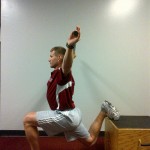
Grasp barbell promoted grip using an overhand open grip, slightly wider than shoulder width. Position barbell chest high with back arched. Place bar in front of shoulders with elbows placed forward and as high as possible. Fingers should be under bar to each side with heels hip width apart or slightly wider. The position of the feet should be at a 45° angle with toes slightly pointed outward.
Descend until knees and hips are fully bent or until thighs are just past parallel to floor. Knees travel outward in direction of toes. Extend knees and hips until legs are straight. Return and repeat.
NOTE: Remember to have good chest back posture. Sit back on your heels and never have your knees over your toes.
Front Squats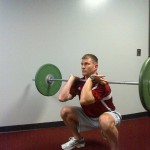
Grasp barbell promoted grip using an overhand open grip, slightly wider than shoulder width. Position barbell chest high with back arched. Place bar in front of shoulders with elbows placed forward and as high as possible. Fingers should be under bar to each side with heels hip width apart or slightly wider. The position of the feet should be at a 45° angle with toes slightly pointed outward.
Descend until knees and hips are fully bent or until thighs are just past parallel to floor. Knees travel outward in direction of toes. Extend knees and hips until legs are straight. Return and repeat.
NOTE: Remember to have good chest back posture. Sit back on your heels and never have your knees over your toes.
Walking Lunges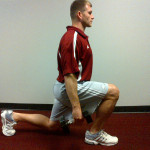
Walking lunges are just like normal lunges, except you move forward rather than perform the exercise stationary position. You move forward as if you were walking, but maintain correct technique during the entire movement.
Note: Use good upright chest and back posture keeping the weight on your heels, never allowing your knees over your toes.
Single Leg RDL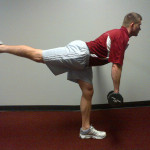
Balance on one leg and hold a dumbbell in the opposite hand at hip or out to the side for balance. With the balancing leg slightly bent and back flat, bend forward at waist until dumbbell is just above floor. Flex glute to extend hip and return to starting position; repeat for specified reps training both legs.
NOTE: Keep your back flat and neck in a natural position while maintaining a good posture in your torso.
Lateral Band Walks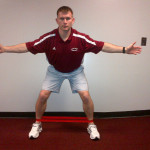
This exercise requires a mini band or lateral resistance band. The mini band is wrapped around the ankles and you are in an athletic position (knees slightly bent, straight back, core activated) throughout the exercise. Take ten lateral steps to the left and then to the right. Your upper body should be in control the entire time. The band should not be springing back to the point of no tension
NOTE: There should always be slight tension on the band and each step should be controlled and deliberate to get the most out of the exercise. Do not allow you heels to click or ever touch! Keep your feet wide.
Med Ball Bucks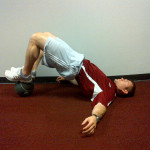
Lie down flat on your back and place the ball under your heels with your knees bend. Begin by extending the hips using your glutes and hamstrings, raising your hips upward as you bridge.Pause at the top of the motion squeezing your glutes and return to the starting position.
NOTE: Keep the med ball close to your rear-end and be under control at all times because this is not a fast moving exercise.
T.K.E – Standing Terminal Knee Extension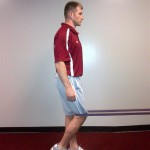
You will need a light or average Jump Stretch Band. Other bands may work just as well. Choke it around a power rack post or any other stable object at knee height. Wrap the other end of the band around your knee. Walk backward so the band is pulling at the back of your knee. With your heel on the floor, bend and flex your knee.
When you flex, make sure to contract your quad as tight as you can for a second or two. You’ll want to do 15-20 reps for a couple sets on each leg. This is also a great warm-up if your knees tend to bother you.
NOTE: There should always be slight tension on the band and take your time with this movement.













